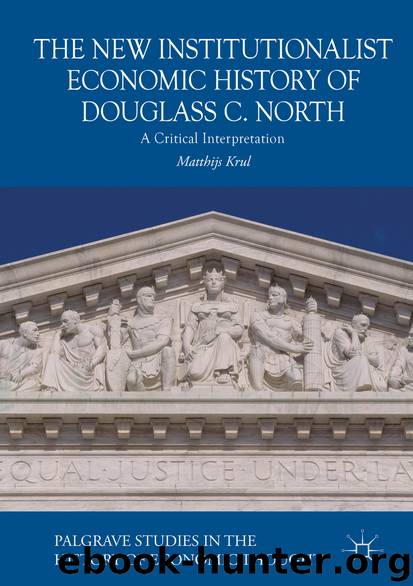The New Institutionalist Economic History of Douglass C. North by Matthijs Krul

Author:Matthijs Krul
Language: eng
Format: epub
ISBN: 9783319940847
Publisher: Springer International Publishing
Rationality and Indeterminacy
Given the above conclusions, we can see that in the final stage of his NIEH North did not succeed at formulating a consistent and coherent theory of action. Instead, he shifted back and forth between different concepts of rationality and decision-making depending on what was convenient for a given argument or on the level of his theory concerned. The remaining task then is to account for how this happened—why North would deploy this inconsistent methodology. There are various possibilities, depending on the degree of charity one wishes to apply in interpreting his work. In any case, it is my conviction that the cause is an underlying problem, one potentially common to all New Institutionalist approaches: indeterminacy.8
The problem is essentially this. The more North extended his model of rationality beyond the confines of strict rationality, the more realistic his approach became. This was, as we have seen, an important motive for his continuous reshaping of NIE theory itself. However, as Uskali Mäki has pointed out, realism can mean various things, not all of whom imply realisticness (see, for example, Mäki 2009). Leaving aside the philosophical meanings of realism for now, realism for North means realisticness. But even so, one must still distinguish realism of assumptions and realism of outcomes. When North discusses realism in the context of his critiques of rational choice theory, he effectively conflates both. His argument is based on the unrealism of outcomes—neoclassical economics is unable to account for social or historical phenomena or their change. But the next step in his theory is to change the realism of the assumptions, both in the form of an enormous set of institutional constraints on rational action and in the form of the occasional appeal to determinants outside traditional choice theory.9 The effect of this, however, is that the determinate predictions offered by strict forms of rational choice theory no longer apply. The broader the kind of inputs into a decision-making process that are permitted or assumed in the model, the greater the number of possible outcomes given a particular situation, and the less determinate conventional choice (or decision) theory will be. Put crudely, if anything can go into the model, anything can come out.10
The same problem operates at the level of institutions. The more North endogenizes social-institutional, historical, cultural, and even psychological elements into his theory, the less room there is for the mechanisms of choice theory to do anything in the explanatory framework. This is not what North intended, as his answer to Polanyi’s challenge required that his theory be based on choice theoretical microfoundations —lest the special explanatory privileges of economics as a discipline be called into question. But the result is a fundamental ambiguity. Wherever he can, North hearkens back to well-understood mechanisms, such as the instrumental rationality of agents responding to incentives or the powerful analytical apparatus of game theory. Precisely because the properties of these analytical tools have been so extensively explored over the past decades, they provide the occasional solid ground for North to anchor his NIEH framework in.
Download
This site does not store any files on its server. We only index and link to content provided by other sites. Please contact the content providers to delete copyright contents if any and email us, we'll remove relevant links or contents immediately.
Pale Blue Dot by Carl Sagan(4613)
The Rules Do Not Apply by Ariel Levy(4523)
Goodbye Paradise(3446)
Ogilvy on Advertising by David Ogilvy(3328)
Delivering Happiness by Tony Hsieh(3283)
Liar's Poker by Michael Lewis(3222)
Into Thin Air by Jon Krakauer(3130)
Purple Cow by Seth Godin(3069)
Rogue Trader by Leeson Nick(2825)
The Social Psychology of Inequality by Unknown(2764)
The Airbnb Story by Leigh Gallagher(2700)
4 - Harry Potter and the Goblet of Fire by J.K. Rowling(2530)
The Mind Map Book by Tony Buzan(2415)
Bossypants by Tina Fey(2373)
All the President's Men by Carl Bernstein & Bob Woodward(2261)
Claridge's: The Cookbook by Nail Martyn & Erickson Meredith(2257)
Six Billion Shoppers by Porter Erisman(2226)
Master of the Game by Sidney Sheldon(2182)
Alibaba by Duncan Clark(1979)
